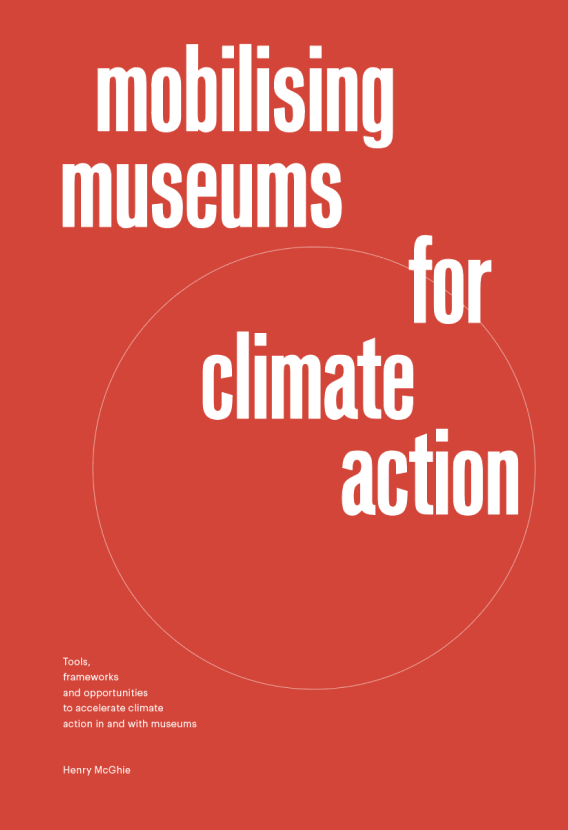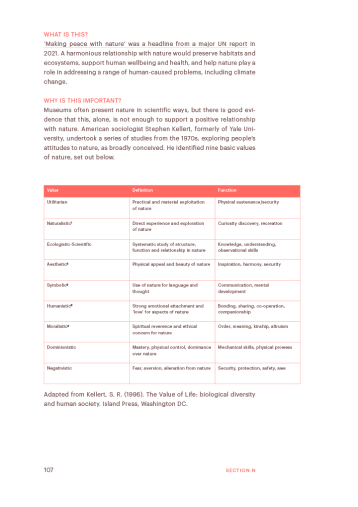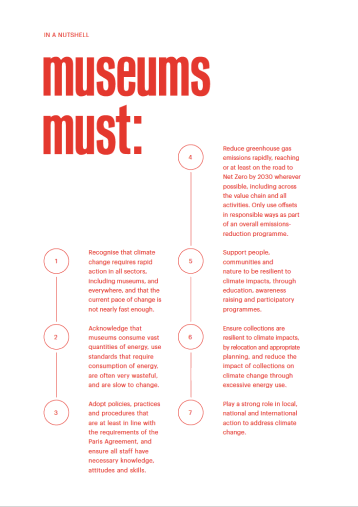Education for Sustainable Development
( Toolbox )
WHAT IS THIS?
Education for Sustainable Development (ESD) is a well-developed pedagogy that can be used by museums throughout their educational activities, for all ages. ESD “empowers learners to take informed decisions and responsible actions for environmental integrity, economic viability and a just society, for present and future generations, while respecting cultural diversity. It is about lifelong learning, and is an integral part of quality education. ESD is holistic and transformational education which addresses learning content and outcomes, pedagogy and the learning environment. It achieves its purpose by transforming society.” (‘Roadmap for Implementing the Global Action Programme on Education for Sustainable Development’, UNESCO, 2014)
WHY IS IT IMPORTANT?
Effective climate education should be rooted in well-developed and informed pedagogies, to ensure that people have opportunities to develop their knowledge, attitudes and skills, to be empowered to take part in climate action, individually and collectively. The Education for Sustainable Development ‘Roadmap’ to 2030 from UNESCO notes:
“For our very own survival, we must learn to live together sustainably on this planet. We must change the way we think and act as individuals and societies. So, in turn, education must change to create a peaceful and sustainable world for the survival and prosperity of current and future generations.”
ESD can help people reduce their personal and collective climate impacts and to adapt to climate change. ESD is explicitly included as an SDG target within SDG 4 (Quality lifelong education), as SDG 4.7.
ESD and Global Citizenship Education (a related approach that is also incorporated into SDG 4.7) use a model based on three domains (dimensions/aspects) of learning: cognitive, socio-emotional and behavioural. This equates to knowledge; attitudes, feelings and values; and practical skills or, more simply, ‘heads, hearts and hands’. To be effective, education should cover all three domains. It is not enough for people to know about problems and challenges: they need to care about them and be empowered to be part of the solution.
‘Education for Sustainable Development: Learning Objectives’ (UNESCO, 2017), is an especially important document, outlining suggested learning objectives for the three domains of learning for each of the SDGs. The learning objectives for SDG 13 (take urgent climate action) are below, although climate change relates to all SDGs.
LEARNING OBJECTIVES FOR SDG 13
Cognitive learning objectives:
- The learner understands the greenhouse effect as a natural phenomenon caused by an insulating layer of greenhouse gases.
- The learner understands the current climate change as an anthropogenic phenomenon resulting from increased greenhouse gas emissions.
- The learner knows which human activities – on a global, national, local and individual level – contribute most to climate change.
- The learner knows about the main ecological, social, cultural and economic consequences of climate change locally, nationally and globally and understands how these can themselves become catalysing, reinforcing factors for climate change.
- The learner knows about prevention, mitigation and adaptation strategies at different levels (global to individual) and for different contexts and their connections with disaster response and disaster risk reduction.
Socio-emotional learning objectives:
- The learner is able to explain ecosystem dynamics and the environmental, social, economic and ethical impact of climate change.
- The learner is able to encourage others to protect the climate.
- The learner is able to collaborate with others and to develop commonly agreed-upon strategies to deal with climate change.
- The learner is able to understand their personal impact on the world’s climate, from a local to a global perspective.
- The learner is able to recognise that the protection of the global climate is an essential task for everyone and that we need to completely re-evaluate our worldview and everyday behaviours in light of this.
Behavioural learning objectives:
- The learner is able to evaluate whether their private and job activities are climate friendly and – where not – to revise them.
- The learner is able to act in favour of people threatened by climate change.
- The learner is able to anticipate, estimate and assess the impact of personal, local and national decisions or activities on other people and world regions.
- The learner is able to promote climate-protecting public policies.
- The learner is able to support climate-friendly economic activities.
The learning objectives are based around the following core competencies (paraphrased from the Learning Objectives guide):
Systems thinking competency: the abilities to recognise and understand relationships in complex systems, and to deal with uncertainty.
Anticipatory competency: the ability to understand and evaluate multiple possible, probable and desirable futures; to create one’s own visions for the future; and to deal with risks and changes.
Normative competency: the ability to understand and reflect on our own values and attitudes that underpin our beliefs and actions; and to understand competing values and how they relate to sustainable development.
Strategic competency: the ability to collectively develop and implement innovative actions at the local and wider levels.
Collaboration competency: the ability to learn from, understand and respect others; and work effectively with others to solve problems together.
Critical thinking competency: the ability to question norms, practices and opinions; to reflect on own one’s values, perceptions and actions; and to take a position in sustainable development.
Self-awareness competency: the ability to reflect on our role in the local community and (global) society; to continually evaluate our own actions, feelings and desires.
Integrated problem-solving competency: the ability to apply different problem-solving frameworks to complex sustainability problems, bringing together the other competencies.
WHAT DOES THIS MEAN FOR MUSEUMS?
Use Education for Sustainable Development, and Global Citizenship Education, as a pedagogical basis for educational and learning programmes, in the development of activities for schools, lifelong learners, in exhibition planning, and in staff training and development.
Ensure that museum educators, exhibition content developers and other communicators are themselves effective agents for Education for Sustainable Development and Global Citizenship Education, and have well-developed ESD competencies.
Connect the three-domain model of learning – thinking, feeling and doing – with activities relating to Action for Climate Empowerment, to support their impact and effectiveness.
Make use of the many resources available, notably from UNESCO, and peer-reviewed learning resources to find good-quality resources.
Share experiences and developments in education and learning practice, to support other museums.
Support the ESD 2030 objectives and initiative (links below), addressing the five priority action areas:
- Advance policy to support and embed Education for Sustainable Development
- Transform learning environments so they support Education for Sustainable Development
- Build the capacities of educators to support Education for Sustainable Development
- Empower and mobilise young people
- Accelerate local-level actions that design and create sustainable futures
FURTHER READING AND INFORMATION
Bremerhaven Declaration LINK
Berlin Declaration LINK
UNESCO ESD 2030 Toolbox LINK
UNESCO 2016. Education 2030 and Framework for Action, UNESCO LINK
UNESCO 2019. Teaching and Learning Transformative Engagement, UNESCO LINK
Global Citizenship Education Clearing House, an online repository of learning resources LINK
UNESCO Portal for Education for Sustainable Development LINK
The Climate Interpreter, a portal from the US National Network for Oceanographic and Climate Change Interpretation and US National Science Foundation LINK
TROPICSU, Teaching Resources to Integrate Climate Topics Across The Curricula, Across the Globe, including lesson plans, links to resources, games, readings and visualisations, with resources available in multiple languages LINK
CLEAN Network (Climate Literacy and Energy Awareness Network), a curated and peer-reviewed collection of high-quality tools to promote climate education LINK
Climate Outreach has many good-quality resources on climate change communication LINK
The Wild Center (Adirondacks, New York State) provides a freely available toolkit and guidance on how to organise Youth Climate Summits LINK
Many of these resources are included in the ICCROM Our Collections Matter Toolkit, which aligns them to particular SDG targets LINK
See sections on:
Action for Climate Empowerment (section k)
Additional learning approaches (section m)
Towards positive relationships with nature (section n)


